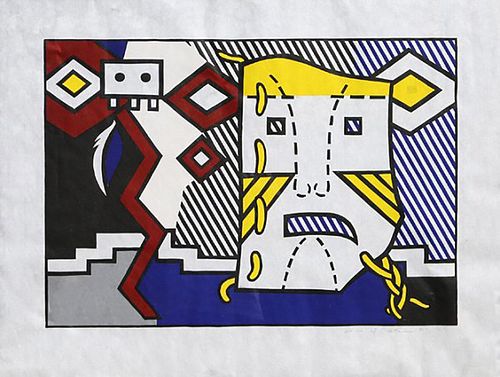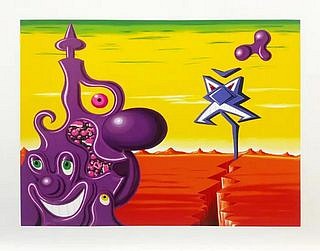Roy Lichtenstein "American Indian Theme V (C. 164)" 1980 Woodcut on Handmade Suzuki Paper, signed an
Lot 72
Categories
Estimate:
$15,000 - $20,000
Absentee vs Live bid
Two ways to bid:
- Leave a max absentee bid and the platform will bid on your behalf up to your maximum bid during the live auction.
- Bid live during the auction and your bids will be submitted real-time to the auctioneer.
Bid Increments
| Price | Bid Increment |
|---|---|
| $0 | $1 |
| $30 | $2 |
| $100 | $10 |
| $500 | $50 |
| $1,000 | $100 |
| $2,000 | $100 |
| $5,000 | $200 |
| $10,000 | $250 |
| $50,000 | $500 |
| $100,000 | $1,000 |
About Auction
By URDE Fine Art Auction
Jul 2, 2024
Set Reminder
2024-07-02 11:00:00
2024-07-02 11:00:00
America/New_York
Bidsquare
Bidsquare : JUNE AFFORDALE ART AND PHOTOGRAPHY SALE
https://www.bidsquare.com/auctions/urde-fine-art-auction/june-affordale-art-and-photography-sale-14875
April sale art & photographs auction Introducing our February auction, Modern, Pop, and Contemporary Fine Art, Sculptures & Fine Photography. URDE Fine Art Auction urdegallery@gmail.com
April sale art & photographs auction Introducing our February auction, Modern, Pop, and Contemporary Fine Art, Sculptures & Fine Photography. URDE Fine Art Auction urdegallery@gmail.com
- Lot Description
American Indian Theme V (C. 164)
By
Roy Lichtenstein - American (1923–1997)
Portfolio: American Indian Theme Series
Date: 1980
Woodcut on Handmade Suzuki Paper, signed and numbered in pencil
Edition of 50, AP 14 (of 18)
Edition number: 13/50
Image Size: 23.25 x 33.5 inches
Size: 31.75 x 41.5 in. (80.65 x 105.41 cm)
Printer: Tyler Graphics Ltd., Bedford Village, New York
Publisher: Tyler Graphics Ltd., Bedford Village, New York
Reference: Corlett 164
Provenance: Tower Gallery, Inc. Southampton, Long Island, NY, Bonhams - Los Angeles CA, United States.
In Excellent condition
Comes with Letter of authenticity
American Indian Theme V (C 164) by Roy Lichtenstein
Roy Lichtenstein takes a modernist perspective of the picture plane by utilizing a method of commercial design through comic strips and advertisement. Lichtenstein integrates the readymade quality of screen prints and integrates a painterly gesture with the use of thick lines, flat surface planes, and obscured perspective.
Roy Lichtenstein’s early appropriation of the aesthetics of American popular culture made him integral to the development of Pop art. Roy Lichtenstein was a student of the work of Pablo Picasso, Joan Mir?, and Paul Klee, Roy Lichtenstein incorporated elements of contemporary art theory and popular print media into his painting. In 1961 Roy Lichtenstein began to replicate the Benday dot system used in mass-circulation printed sources such as comics, newspapers, and billboards; this would become a signature element of Roy Lichtensteins painting and sculpture. By mimicking this industrial method and appropriating images from high and low culture, Roy Lichtenstein’s work realized a broader accessibility that had not yet been achieved in contemporary art. Roy Lichtenstein’s most recognizable series evolved from imagery drawn from popular culture: advertising images, war-time comics, and pin-up portraits, as well as traditional painting genres.
About Roy Lichtenstein:
Roy Lichtenstein was a pop art painter whose works, in a style derived from comic strips, portray the trivialization of culture endemic in contemporary American life. Using bright, strident colors and techniques borrowed from the printing industry, he ironically incorporates mass-produced emotions and objects into highly sophisticated references to art history.He was one of the first American Pop artists to achieve widespread renown, and he became a lightning rod for criticism of the movement.
Primary colors–red, yellow and blue, heavily outlined in black–became his favorites. Occasionally he used green. Instead of shades of color, he used the benday dot, a method by which an image is created, and its density of tone modulated in printing. Sometimes he selected a comic-strip scene, recomposed it, projected it onto his canvas and stenciled in the dots. “I want my painting to look as if it had been programmed,” Lichtenstein explained.ExcellentCondition
- Shipping Info
-
Bidder Can Make Shipping Arrangements, Local Pick-Up, In-House Shipping
-
- Payment & Auction Policies
-
Available payment options
-
- Buyer's Premium



 EUR
EUR CAD
CAD AUD
AUD GBP
GBP MXN
MXN HKD
HKD CNY
CNY MYR
MYR SEK
SEK SGD
SGD CHF
CHF THB
THB

















